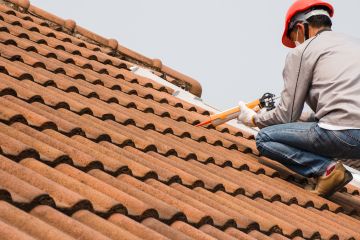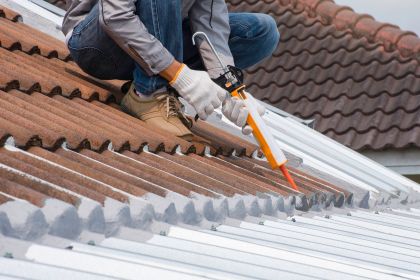Is roof cement the same as tar?
Even though it resembles tar at first glance, there are variations. Tar is only water-resistant; roofing cement creates a barrier that is waterproof. Unlike oily tar, which runs in dark streaks down your ceiling, cement is denser and more durable.
Sealant and cement are not the same thing. Going back to the drywall example, sealant is slimmer and comparable to paint, whereas cement is like a thick spackle.
Some roofing concrete is only suitable for dry conditions. Use cement designated for use in wet environments, also known as dry/wet patch or maybe all patch, if you need to repair a sweaty ceiling or live in a humid or rainy climate.
Although the terms bitumen, flashing, and pvc cement are frequently used interchangeably, low-slope repairs or dry roofs are the only situations in which plastic concrete may be used.
What do you use roofing cement for?
Strong roofing cement is typically created from ground asphalt. It is used to repair a roof’s holes, leaks, and other problems. Because it is a powerful adhesive, roofing cement is frequently used to reattach damaged shingles or trim.
Strong roofing cement is typically created from ground asphalt. It is used to repair a roof’s holes, leaks, and other problems. Because it is a powerful adhesive, roofing cement is frequently used to reattach damaged shingles or trim. It’s a common choice for DIY roofing projects because it’s simple to buy at the hardware store.
Can you put cement on a roof?
Roofing cement can be a fantastic way to temporarily fix the leak site until a qualified roofer arrives if you are dealing with an emergency leak. For minor cosmetic problems, a do-it-yourself fix may be effective. To look for more serious damage, it’s crucial to have your roof inspected first.
Both professionals and amateurs use roofing cement. This is due to its dependability, usability, and accessibility. However, it’s typically employed to patch small leaks or holes. It shouldn’t be applied to larger areas of destruction without also covering them properly with rolled roof installation or another material. You can repair damaged roof components by reattaching them with roofing cement.

What is modified roofing material?
To create a tough-yet-pliable watertight seal, asphalt is combined with polymerized elastomers or plastic and reinforced with fiberglass. Most commercial roofs that are flat or have a low slope use modified bitumen roofing.
Built-up roofing systems (BUR), which have been used on reduced roofs for more than a century, are regarded as modified bitumen’s evolutionary cousin. To create a tough-yet-pliable waterproof membrane, asphalt is aggregated with polymerized rubber or pvc and reinforced with fiberglass.
Commercial roofs with low slopes or flat surfaces typically use modified bitumen roofing. These membranes can be installed as a component of a multi-ply system or a two-layer system, based on the type and material.
How do you use plastic roof cement?
The plastic flat roof cement is applied to the roof with a trowel after being acquired in a can or jug container. If you need to patch rips or caulk difficult-to-reach places, you can also use a caulking gun.
Your roof is made of a variety of materials to guarantee longevity and durability. A substance called plastic roofing concrete is used to waterproof your roof and makes it easier to apply new roofing systems over an existing pavement like shingles. It may be used with concrete frames surfaces, as well as a variety of other materials.
What is the best roof sealant?
Roof sealants offer a protective cover to thwart the entry of water and sunlight in addition to covering roof leaks. These sealants are available in a variety of forms, such as liquid in paint cans, liquid in spray cans, liquid in caulk guns, and adhesive tape. Additionally, they come in a variety of materials like rubber and polyurethane.
Here the top sealants for roof leaks to find out more about which kind is best for your application.
- Self-Leveling Lap Sealant by Dicor.
- Waterproofing liquid rubber sealant
- Flex Seal Can of Liquid Rubber
- Gorilla Patch & Seal Waterproof Tape.
- Rubber Sealant Coating Flex Seal Spray.
Is tar good for roof leaks?
It is possible to find internal leaks by removing the tiles, and an inner ceiling leak can be fixed with roofing tar. A shingle or piece of plywood can be used as support for roofing tar to improve its performance.
A roof can be covered with tar in as little as 40 degrees Fahrenheit. However, until the temperature reaches at least 70 degrees, it won’t properly dry and seal. Furthermore, never apply tar when it’s very hot outside, like in the middle of the summer.
Tar and gravel roofs typically last 25 years, but with exceptional care, they can last up to 40 years. This is because the materials, like the embedded gravel, are resilient and don’t degrade easily.
What is a roof tar?
A dark, oily substance called shingle roof tar is implemented to flat roofs to stop leaks. It is created using petroleum byproducts and coal tar. A dark brown or black residue called coal tar is created during the mining of coal.
A type of metal roof tar called rosin roof concrete is used to seal, gilts, or repair damaged or worsening roof areas. The asbestos in more recent roofing tar compositions has been eliminated, but they may still contain organic solvent, surface adherents, plastics, and mineral admixtures. Other types of roofing tars are applied like paint or sealant, while coal tar roof concrete is applied with a trowel.


